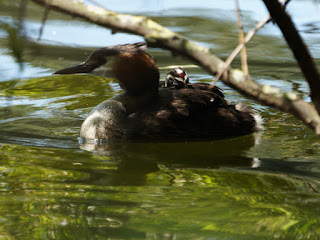A Magpie took a cooling drink from the lake.
Most of the small birds were staying in deep shade. But Little Owls are adapted to the Mediterranean climate and not bothered by English summer temperatures, and the female was out in her usual alder tree having a scratch.
The pigeon-eating Lesser Black-Backed Gull was with his mate at the Dell restaurant, but there were few pigeons and they were not in places where they could be caught.
A Cormorant flew down the Long Water.
The Great Crested Grebes in the nest under the willow near the bridge have at least one chick. They were in an awkward place and this is the best picture I could get.
Two of the chicks of the other grebe family could be seen farther up the Long Water. The two families have nested close to each other and there will be territorial disputes.
The grebes' nest at the west end of the island is now as complete as it will ever get, and there was a bird sitting in it. Not a bad place, since it's screened by a mesh net at the front and a wire basket at the back.
The Mute Swan with three cygnets took them to Peter Pan to teach them the art of begging. But there was no one there except me, and I don't feed swans. They went off in a huff.
Moulting their flight feathers makes waterfowl itchy and irritable. Two swans have now been seen with bloodstained wings. Jorgen suggested that they have not been attacked, but have made themselves bleed by constantly scratching and preening.
A swan worked it off by rushing around, flapping its denuded wings, and chasing some harmless Greylag Geese.
A Mallard had five ducklings under the same willow as the grebe shown above.
The other Mallard on the Long Water still has two, and brought them over to the Vista.
An Egyptian Goose stretched a recently regrown wing. The iridescent green secondaries are a feature of ducks, not true geese, and a reminder that the species is misnamed.
A Small Red-Eyed Damselfly rested on a patch of algae in the Italian Garden fountains.
A Common Blue Damselfly perched on a grass seed head.
A pleasing picture from St James's Park by Joan Chatterley. The pair of Black Swans, undaunted by their previous cygnets having been killed by a Mute Swan, and their second clutch of eggs not hatching, have moved to other other end of the lake and are nesting on the Pelican Rocks.














That’s an unusual place to nest! I wonder what the pelicans think about it?
ReplyDeleteI was wondering about that too. Don't want to see a battle of the giants.
DeleteI fear the worst. Although I have trust in the courage and strength of black swans.
ReplyDeleteThat poor swan is clearly off its gourd with itching. It must be terrible. Why won't you feed swans, by the way? I have largely forgiven the swan that nearly bit my finger clean off when I made him a food offering. Not to the point of being willing to risk more fingers though.
Love the picture of the baby Grebes. And the perfectly shaped little foot of the Little Owl.Instrument of death and terror it may be, but it's so cute!
I don't feed swans because I want them to keep away from humans who will feed them bread, which can choke them. It's a useless effort, of course. Those brand new cygnets are already on the downward path.
DeleteRalph your photo is of a male Small Red-eyed not Red-eyed Damselfly. I've seen my first a couple of days ago. The wedge of blue under segment 8 is clear in your photo & is diagnostic. A smaller damselfly with paler more tomato red eyes & has shorter wings, though this may not be so obvious in one individual. Presumably you only had Small Red-eyed then?
ReplyDeleteThank you. Changed. Silly of me, but I was expecting the X mark on the tip of the abdomen to be more clearly defined.
DeleteThanks for the bleeding swan explanation...phew..
ReplyDeleteLove the two damselflies pics..such unique and unusual shades of blue..